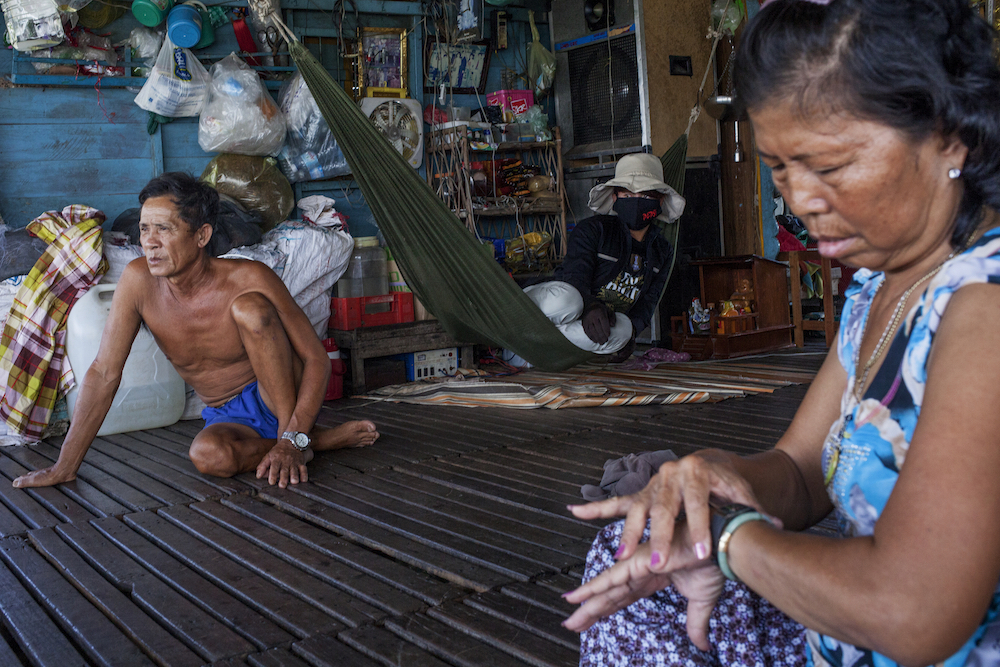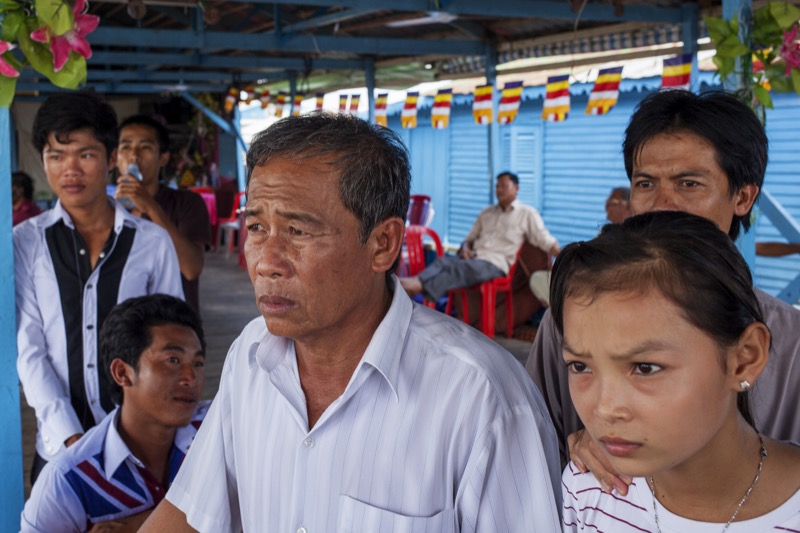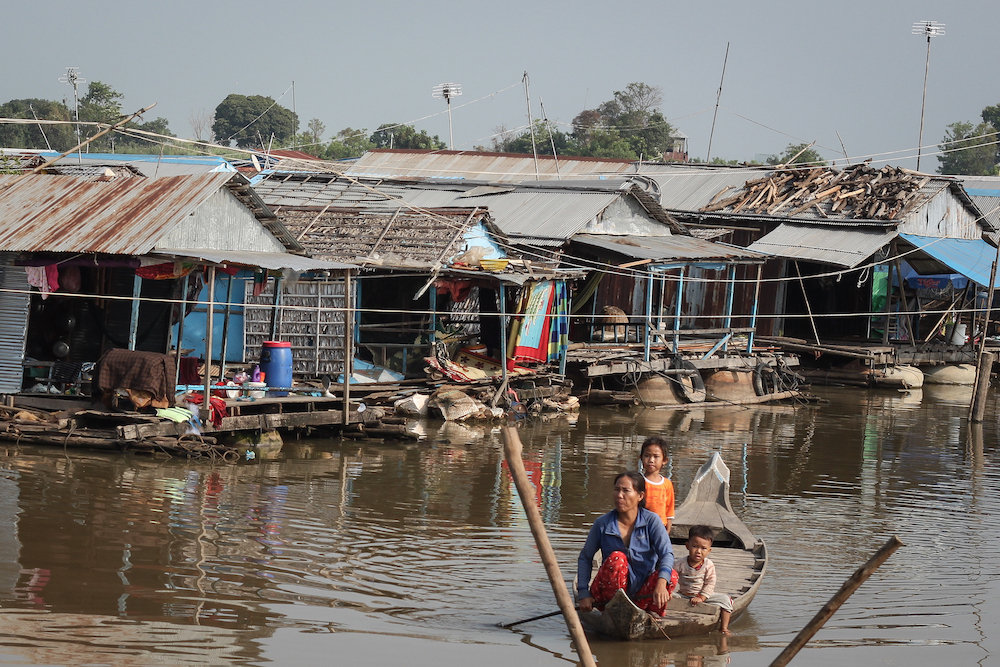
Forever Foreign
Many have viewed Vietnam as Cambodia’s arch-enemy, a consequence of history. In the wake of such hostility, ethnic Vietnamese who call Cambodia home are forever seen as strangers
By Michelle Vachon and Chhorn Phearun
September 1, 2017
Tri Ngan Ros lives in a boathouse on the Mekong River. Born in Kompong Chhnang province during Prince Norodom Sihanouk’s regime, the 60-year-old fisherman can’t recall when his father came to Cambodia.
All his life, this country has been his home. His four children and nine grandchildren were also born in Cambodia. Yet, he says, “I don’t have a Cambodian identification card. I’ve been here for a long time. It has been three generations and I still have an immigrant status.”
Among the 1,000 families with Vietnamese heritage living in Mr. Ros’ floating village, very few families have identification cards, he said. They are caught in a legal limbo: born in Cambodia, yet considered strangers. The roots of the conflicted status stretch far back into Cambodia’s history, yet the repercussions continue to define individual identities today and condemn generations of people to dwell in a legal no-man’s land. Derided as “yuon,” vilified by politicians and snubbed by schools, they have long been used as scapegoats by all sectors of Cambodia’s society.
Leaf through Cambodia’s history and the Vietnam-Cambodia relationship often appears as the centerpiece or backdrop of periods or specific moments.
Consider Paris, 1991. At the time, negotiations were underway that would lead to the Paris Peace Agreement on October 23 that would put an end to the war in Cambodia. Dr. Richard Rechtman, a French doctor, was attending an official dinner in the city.
The event was for those from the different factions who, throughout the 1980s, had fought the Cambodian government that had ousted the Khmer Rouge regime in 1979 with Vietnam’s assistance.
However, it was strictly prohibited to mention the Vietnamese at dinner, Dr. Rechtman said. So much so that when an entertainer began a Vietnamese song, everyone in the room insisted she stop.
Using his diagnostic eyes as a psychiatrist, he found this unsurprising. “It’s always easier to pick someone entirely foreign as being the enemy,” he said.
“One had the feeling that everyone was on good terms,” Dr. Rechtman said. “And yet, one woman at my table told me that, during the Khmer Rouge regime, she had lost many members of her family and that, at the next table, here was the man she was convinced had been highly responsible for this.”
“This meant that, even though the enemies were well known…one preferred making the Vietnamese the heart of the problem plaguing Cambodia,” Dr. Rechtman said.

During the following years, hatred for the Vietnamese became a way for Cambodians to channel their anger at crimes committed by the Khmer Rouge. And they did this without being aware that they were using the Vietnamese as scapegoats, Dr. Rechtman said. After all, Cambodia and Vietnam had a long history of conflicts.
Even when the Peace Agreement put an end to two decades of war and conflict in Cambodia, people of Vietnamese ancestry living here have often been victims of this displaced anger.
This rage has often sparked violent acts, no doubt seen as retribution by the perpetrators.
In 1998, for instance, several people of Vietnamese background were lynched by mobs in Phnom Penh following unfounded rumors that they had poisoned the city’s food and water. And two years ago, a man of Vietnamese descent, Nguyen Yaing Ngoc, was injured in a traffic accident, then killed by a mob as he was lying in the street. The deputy commune police chief at the time said someone had shouted “Yuon fight with Khmer!” before the attack.
Politicians have not been restrained in expressing their views either.
Sam Rainsy, the CNRP’s former president now in exile, has been known for his virulent attacks against Vietnam and the Vietnamese in the country. In a letter to The Cambodia Daily on October 28, 2013, he protested about being accused of pillorying the Vietnamese living here. He then argued that Vietnamese immigrants could end up outnumbering the Khmer as Vietnamese companies were grabbing land, a rhetoric he had repeated before, including at a political rally.
Asked for comment for this story, Mr. Rainsy wrote that he had a profound respect for human rights. However, he wrote, “this does not prevent me from denouncing numerous elements of communist Vietnam’s expansionist and hegemonic policy towards Cambodia.”
One rumor that made some Cambodians weary in the 1990s was hearing that millions of Vietnamese had settled in the country in the 1980s. According to Patrick Heuveline, a French sociologist specializing in demographic analysis, the number was closer to 400,000: 200,000 Cambodians of Vietnamese heritage who had fled Cambodia in the 1970s, and 150,000 to 200,000 Vietnamese who resettled in the country.
This figure is based on an extensive analysis by U.S. jurist Jennifer Berman, who studied Cambodia’s citizenship process in 1996. “Nationality is a contentious subject for a country that, in a little over 50 years, has been under the rule of the French [after signing the Protectorate Treaty] and the Vietnamese [in the 1980s], occupied by the Japanese [for a few months during World War II], and administered by the United Nations [prior to the 1993 national elections],” she writes in her study.

“Foreign rules in Cambodia has engendered, particularly among ethnic Khmers, a sense of exclusion from participation in internal affairs and a deep distrust, bordering often on paranoia, of the presence and intentions of non-indigenous ethnic minorities in Cambodia. That distrust has penetrated deep into Cambodian society, laws and institutions and often manifests itself today in blatant ethnic discrimination.”
In addition, Cambodia has a long and at times painful history with Vietnam as today’s students learn at school.
In the early 17th century, a Cambodian king married a Vietnamese princess, according to French historian Alain Forest. As part of the agreement, Vietnam was allowed to set up customs posts in the Mekong delta, bringing in Vietnamese immigrants who would eventually surpass the Cambodian population and take over the region known today as Kampuchea Krom.
Several decades later, a Cambodian prince seized the throne and converted to Islam. His rivals sought Vietnam’s support to oust him. “The pattern would continue for each reign change. The challenger would seek the support of either Siam—today’s Thailand—or Vietnam,” Mr. Forest said.
Conflicts within the country enabled those two powerful neighbors to interfere in Cambodia’s politics.
According to Mr. Forest, the two countries wanted different things. Vietnam was after land. The Siamese captured northern Cambodians and took them to Siam as slaves.
This period proved terrible for Cambodians, Mr. Forest said. It would end with King Ang Duong making a first appeal to the French to stop the country’s two neighbors, and leading his successor King Norodom to sign the Protectorate Treaty in 1863. By then, the country’s population was down to 900,000 people and its territory did not extend beyond Kompong Thom province.
As Keo Duong, a history professor at the Royal University of Phnom Penh, wrote in a research document on ethnic Vietnamese last year, during Prince Norodom Sihanouk’s regime in the 1950s and 1960s, those of Vietnamese background were not considered Cambodians even if they had been born in Cambodia. An exception was made for those from Kampuchea Krom.
Ethnic Vietnamese could become citizens if they spoke Khmer and had lived here a certain number of years. But people Mr. Duong interviewed did not seem aware of this: they only knew they had to pay annual immigration fees at rates prohibitive for fishermen families.
When Prince Norodom Sihanouk was voted out of power by the National Assembly in March 1970 and Lon Nol took over as head of government, one of his first decisions was to order all those of Vietnamese heritage to be expelled or killed. This led to outright massacres, recalled Father Francois Ponchaud who served in Catholic villages of ethnic Vietnamese.
“They arrested all the men 15 years of age and older, forced them into landing barges and headed south. About thirty kilometers away, soldiers tied their hands behind their backs, linked them up in groups of ten and shot them,” he said. “The bodies fell into the water.”
Upon hearing of this, the South Vietnamese government, which was fighting North Vietnam’s communist forces with U.S. support and was an ally of Cambodia, organized the departure of more than 200,000 people, even though many born in Cambodia had never been to Vietnam.
As the civil war raged, the Lon Nol regime displayed posters depicting the enemy as the North Vietnamese, with no mention that this was a civil war among Cambodian factions.
When the Khmer Rouge seized power in April 1975, the Vietnamese were the enemy to destroy, even though North Vietnamese forces had fought alongside them until 1972-1973. As French historian Henri Locard explains in his book “Pol Pot’s Little Red Book, The Sayings of Angkar” some Khmer Rouge slogans targeted Vietnamese such as “Smash the Viets! Smash them until you break their backs!” and “Let us violently attack and scatter the Vietnamese vermin!” Khmer Rouge attacks on Vietnamese villages on the Vietnam side of the border later prompted Vietnam to oust Pol Pot’s government with a contingent of Cambodian soldiers who had fled the regime and taken refuge in Vietnam.
Having defeated the Khmer Rouge, the reaction of Western countries took Vietnam aback, said U.S. journalist Elizabeth Becker.
“I don’t think that history has been entirely written. But there’s no question: Vietnam expected to be applauded for getting rid of the Khmer Rouge. It was shock at their reception. Vietnam expected the rest of the world to say ‘Bravo Vietnam for getting rid of horrible Khmer Rouge.’ They were not prepared for the hostility.”
In the 1980s, she said, “It’s tortured to entirely blame Vietnam because the Vietnamese got rid of the Khmer Rouge and stopped the genocide… If you want to get angry, get angry at the United States for supporting the Khmer Rouge throughout the 1980s. If you want to get angry, get angry at most of the West for refusing to help Cambodia come back to life. Instead of giving aid, the United States, Europe and…most of the West plus Asean had severe sanctions and refused to allow aid to go into Cambodia.”
“The Vietnamese should have left much earlier: no question…However to single Vietnam out as the sole problem in the 1980s is completely weird,” Ms. Becker said.
Since the Vietnamese government and military remained in the country until 1989, opposition parties would continue for several years to associate the ruling party, renamed the Cambodian People’s Party, with Vietnam.
And, because of the decades-old ties between Hanoi and CPP leaders, the opposition party, the CNRP, still feels that Vietnam has been allowed to snatch clumps of land along the border without the CPP wishing to call out Vietnam.
“The border issue is an issue,” CNRP vice president Mu Sochua said last week.
“We cannot deny that there are border issues. And as neighbors…if CNRP is in government, then the foreign policy is resolution to non-violence, peaceful resolution, dialogue, of calling and implementation of the…law going as far as international court if there is no resolution bilaterally.”
This said, Ms. Sochua added, “any form of racism is not an excuse and is not condoned by the party… We have taken measures within the party and from as a party calling for non-violent resolutions.”
Today, ethnic Vietnamese are often small vendors or merchants. Others live in floating villages like Tri Ngan Ro, earning a living as fishermen as best as they can. Those who are not recognized as legal immigrants cannot get birth certificates for their children, and without birth certificates, children cannot attend public school, said Nou Va, deputy director of the Minority Rights Organization.
“People who come from one country and are not eligible, according to the government, to get legal identity, live with what we call unclear identity: They live in one country but have no documents.”
And yet, many who live in that floating village in Kompong Chhnang province were born in Cambodia, he said. “The nationality law mentions that children who were born of foreigners who live legally in Cambodia will get Cambodian citizenship. So the question is what does ‘legally’ mean: That’s the big question,” Mr. Va said.
“They are so poor that they cannot send their children to school,” he said.
Since their parents did not have the chance to learn Khmer, the children only speak the Vietnamese language spoken in the floating village.
“How can they communicate…in Khmer, the language of the country in which they live? How can they compete in the workplace in the future, how can they find good jobs?” Without Khmer language skills, they will have no choice but to remain in their communities and will not be able to contribute to the development of Cambodia, Mr. Nou said.
“Cambodia is not developed by original Khmer only, but also by people from different backgrounds: Cham, Chinese, indigenous people, Vietnamese and so on. People from different races and backgrounds who join to develop this country,” he added.
The future of these children rests on clearly defining “legally” in the law to establish their parents’ status.
Asked about the issue, Eng Chandara, director of the department of birth, marriage and death certificates at the Interior Ministry, explained that “foreigners who live in Cambodia with a visa legally can get birth certificates although the birth certificate is registered as being for foreigners and not Cambodian.”
A person without a visa is an illegal immigrant, Mr. Chandara pointed out. Most people of Vietnamese background living in floating villages in Kompong Chhnang province are illegal immigrants. “We are working on that: We don’t want children to be born without identity,” he said.
Over the years, the former CNRP leader Sam Rainsy has defended himself repeatedly for having used the term “yuon” to describe people of Vietnamese origin: It simply means Vietnam or Vietnamese in Khmer, he contends. In his 1967 Khmer-language dictionary, the revered monk and scholar Chuon Nath defined the term “yuon” as referring to people of Tonkin, Annam and Cochinchina regions in Vietnam. The word, however, seems to have acquired a negative connotation during the 1980s when Vietnam was overseeing Cambodia run by the party that would later be renamed the CPP. This differentiation between Khmer and Vietnamese raises an important issue, said Tim Frewer, an Australian human-geography academic who has been studying Cambodia for more than a decade.
“What’s different between nationalism and racism is that…it is claiming there is an inherent problem with a particular race and excluding that race from what it means to be Cambodian,” he said.
“So it’s not just a matter of disliking Vietnamese because of political ire or historical conflicts. It’s a matter of people actually saying Vietnamese have no place, no matter where they come from, in Cambodia, they have no place in the nation, they should be excluded. And it’s only once they’re excluded that we can find ourselves…it’s all about pushing the Vietnamese…as a threat to Cambodianism,” he added.
How do Cambodians in their 20s or early 30s think about such attitudes borne out of an era before their time?
“The young generation, they don’t want to have a war and they don’t want to lose and lose territory at the border again, said Tim Malay, president of the Cambodian Youth Network and a Masters student.
“People still want peace, want development…So the young generation, we look for a new solution.”
They hope that the government elected next year will resolve the issues through legal channels, he said. Foreigners who may have made Cambodia home have their own views.
“As you know, virtually all Cambodians have strong negative feelings about Vietnam and the Vietnamese people,” said Bill Herod, who has been in Cambodia for more than 30 years. “However, I would say that’s a general feeling. It doesn’t really work in person-to-person relationships.”
Mr. Herod, who first came to Cambodia in the 1980s as an aid worker and now lives in Mondolkiri province, has both Vietnamese and Khmer friends.
“I have many Cambodian friends who have Vietnamese friends and when I talk to them about it, they say bad things about the Vietnamese people. But then I say, ‘Well what about this person?’ and they say, ‘Oh, you know, they’re nice people. I like them.’”
As for using the term “yuon,” Mr. Herod said, “Of course I don’t use the word in conversation myself…But I don’t think it’s as derogatory as we sometimes think. And I have heard Vietnamese use the word themselves.”
“I hope that the ‘yuon’ word will get lost and we will be referring to Vietnamese as Vietnamese,” he said.
(Additional reporting by Van Roeun)



